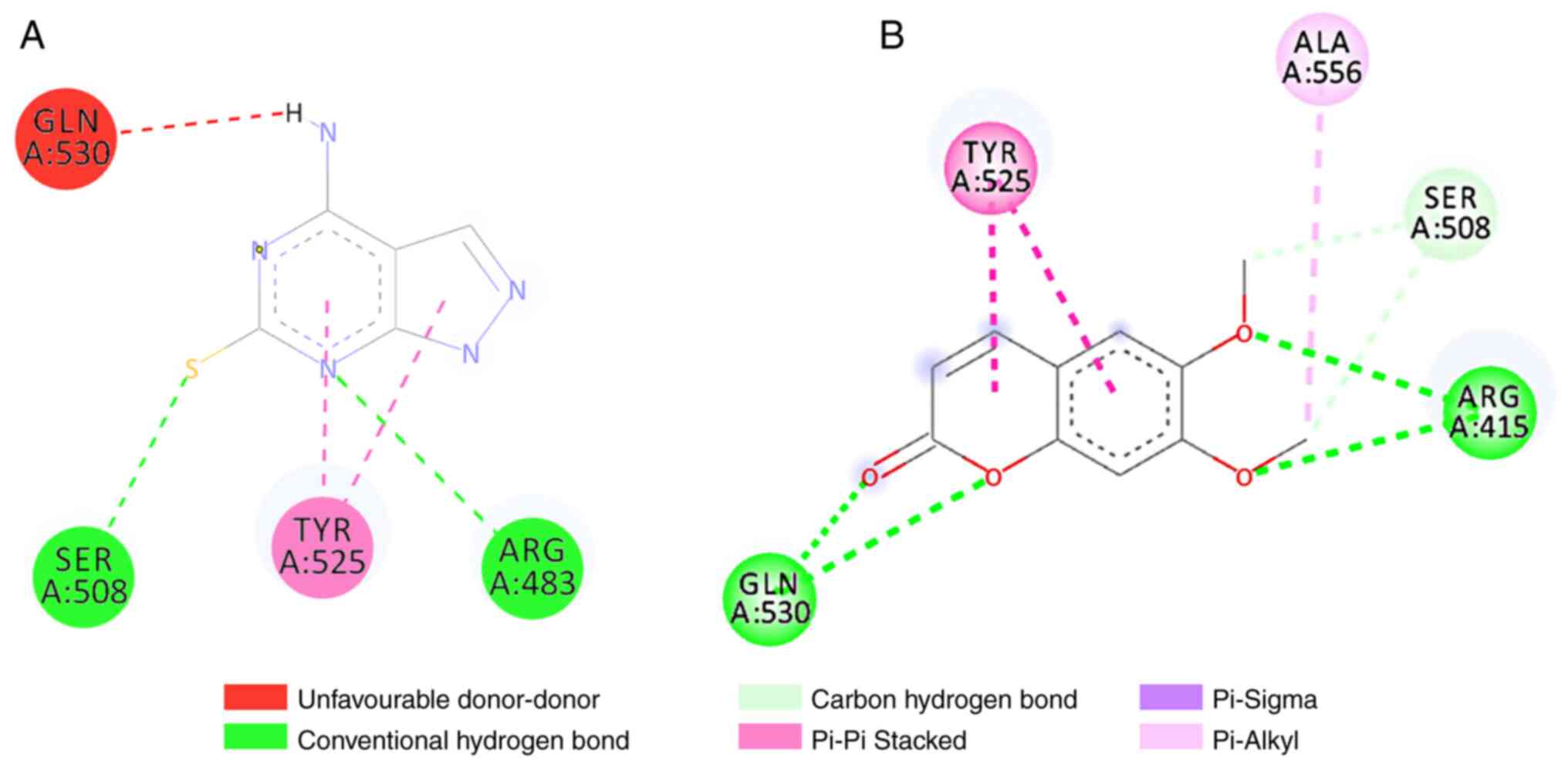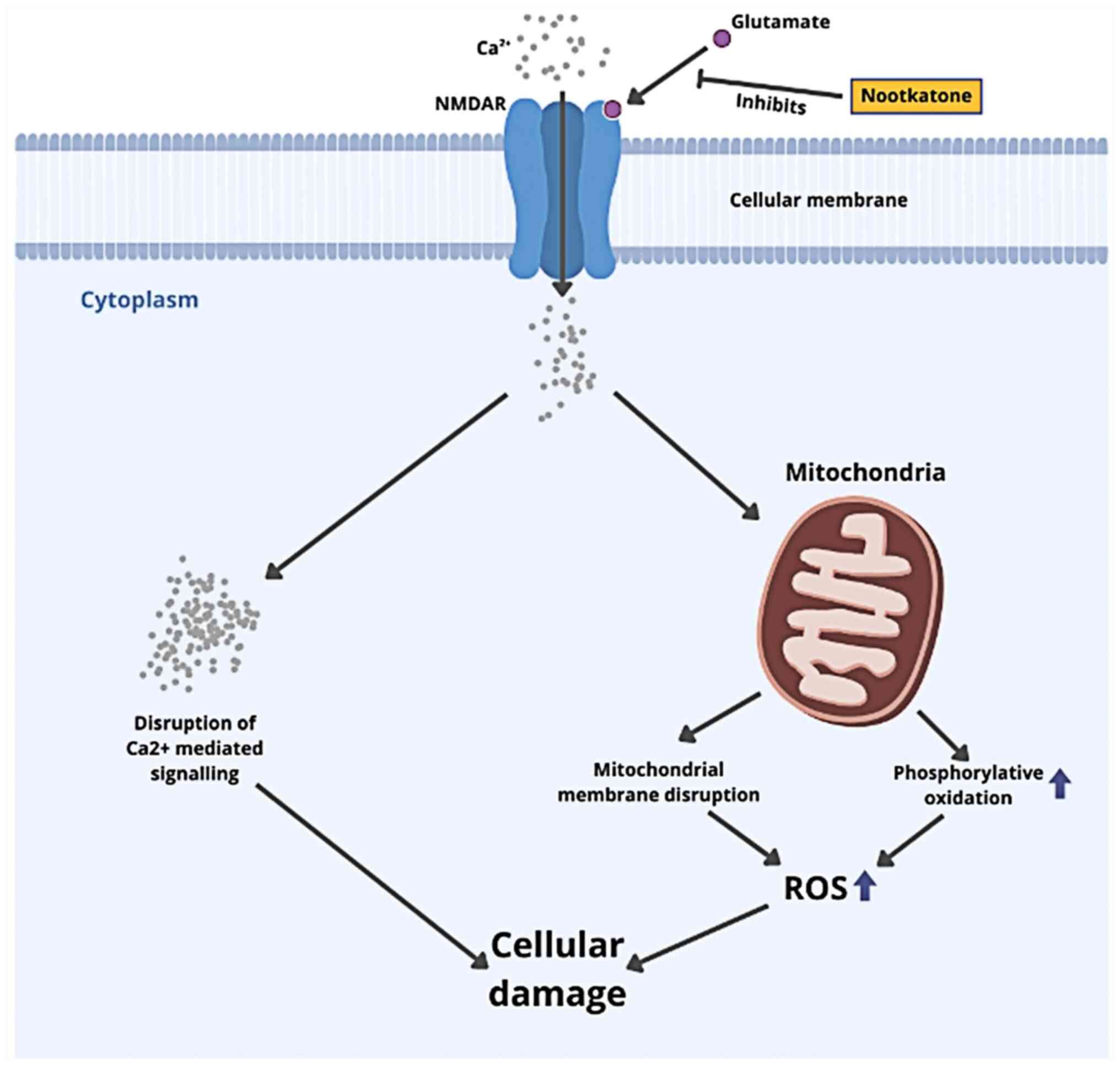|
1
|
Maas AIR, Menon DK, Adelson PD, Andelic N,
Bell MJ, Belli A, Bragge P, Brazinova A, Büki A, Chesnut RM, et al:
Traumatic brain injury: Integrated approaches to improve
prevention, clinical care, and research. Lancet Neurol.
16:987–1048. 2017.PubMed/NCBI View Article : Google Scholar
|
|
2
|
Xiong C, Hanafy S, Chan V, Hu ZJ, Sutton
M, Escobar M, Colantonio A and Mollayeva T: Comorbidity in adults
with traumatic brain injury and all-cause mortality: A systematic
review. BMJ Open. 9(e029072)2019.PubMed/NCBI View Article : Google Scholar
|
|
3
|
Dorsett CR, McGuire JL, DePasquale EAK,
Gardner AE, Floyd CL and McCullumsmith RE: Glutamate
neurotransmission in rodent models of traumatic brain injury. J
Neurotrauma. 34:263–272. 2017.PubMed/NCBI View Article : Google Scholar
|
|
4
|
Thapa K, Khan H, Singh TG and Kaur A:
Traumatic brain injury: Mechanistic insight on pathophysiology and
potential therapeutic targets. J Mol Neurosci. 71:1725–1742.
2021.PubMed/NCBI View Article : Google Scholar
|
|
5
|
Khatri N, Thakur M, Pareek V, Kumar S,
Sharma S and Datusalia AK: Oxidative stress: Major threat in
traumatic brain injury. CNS Neurol Disord Drug Targets. 17:689–695.
2018.PubMed/NCBI View Article : Google Scholar
|
|
6
|
Kurniawan DB, Syaban MFR, Mufidah A,
Zulfikri MUR and Riawan W: Protective effect of Saccharomyces
cerevisiae in Rattus norvegicus Ischemic Stroke Model. Res J Pharm
Technol. 14:5785–5789. 2021.
|
|
7
|
Kansanen E, Kuosmanen SM, Leinonen H and
Levonen AL: The Keap1-Nrf2 pathway: Mechanisms of activation and
dysregulation in cancer. Redox Biol. 1:45–49. 2013.PubMed/NCBI View Article : Google Scholar
|
|
8
|
Baird L and Yamamoto M: The molecular
mechanisms regulating the KEAP1-NRF2 pathway. Mol Cell Biol.
40:e00099–20. 2020.PubMed/NCBI View Article : Google Scholar
|
|
9
|
Bhowmick S, D'Mello V, Caruso D and
Abdul-Muneer PM: Traumatic brain injury-induced downregulation of
Nrf2 activates inflammatory response and apoptotic cell death. J
Mol Med (Berl). 97:1627–1641. 2019.PubMed/NCBI View Article : Google Scholar
|
|
10
|
Liang J, Wu S, Xie W and He H: Ketamine
ameliorates oxidative stress-induced apoptosis in experimental
traumatic brain injury via the Nrf2 pathway. Drug Des Devel Ther.
12:845–853. 2018.PubMed/NCBI View Article : Google Scholar
|
|
11
|
Rafiq S, Kaul R, Sofi SA, Bashir N, Nazir
F and Ahmad Nayik G: Citrus peel as a source of functional
ingredient: A review. J Saudi Soc Agric Sci. 17:351–358. 2018.
|
|
12
|
Saini RK, Ranjit A, Sharma K, Prasad P,
Shang X, Gowda KGM and Keum YS: Bioactive compounds of citrus
fruits: A review of composition and health benefits of carotenoids,
flavonoids, limonoids, and terpenes. Antioxidants (Basel).
11(239)2022.PubMed/NCBI View Article : Google Scholar
|
|
13
|
Singh B, Singh JP, Kaur A and Singh N:
Phenolic composition, antioxidant potential and health benefits of
citrus peel. Food Res Int. 132(109114)2020.PubMed/NCBI View Article : Google Scholar
|
|
14
|
Abdelghffar EA, El-Nashar HAS,
AL-Mohammadi AGA and Eldahshan OA: Orange fruit (Citrus sinensis)
peel extract attenuates chemotherapy-induced toxicity in male rats.
Food Funct. 12:9443–9455. 2021.PubMed/NCBI View Article : Google Scholar
|
|
15
|
Li X, Xie P, Hou Y, Chen S, He P, Xiao Z,
Zhan J, Luo D, Gu M and Lin D: Tangeretin inhibits oxidative stress
and inflammation via upregulating Nrf-2 signaling pathway in
collagen-induced arthritic rats. Pharmacology. 104:187–195.
2019.PubMed/NCBI View Article : Google Scholar
|
|
16
|
Sahu DR, Chowdhury B and Sahoo BM:
Anti-convulsant action and attenuation of oxidative stress by
citrus limon peel extracts in PTZ and MES induced convulsion in
albino rats. Cent Nerv Syst Agents Med Chem. 20:177–185.
2020.PubMed/NCBI View Article : Google Scholar
|
|
17
|
Pinzi L and Rastelli G: Molecular Docking:
Shifting paradigms in drug discovery. Int J Mol Sci.
20(4331)2019.PubMed/NCBI View Article : Google Scholar
|
|
18
|
Sander T, Freyss J, von Korff M, Reich JR
and Rufener C: OSIRIS, an entirely in-house developed drug
discovery informatics system. J Chem Inf Model. 49:232–246.
2009.PubMed/NCBI View Article : Google Scholar
|
|
19
|
Rahman PA, Syaban MFR, Anoraga SG and
Sabila FL: Molecular docking analysis from Bryophyllum pinnatum
Compound as A COVID-19 cytokine storm therapy. Open Access Maced J
Med Sci. 10:779–784. 2022.
|
|
20
|
Zhong M, Lynch A, Muellers SN, Jehle S,
Luo L, Hall DR, Iwase R, Carolan JP, Egbert M, Wakefield A, et al:
Interaction energetics and druggability of the protein-protein
interaction between Kelch-like ECH-Associated Protein 1 (KEAP1) and
nuclear factor erythroid 2 like 2 (Nrf2). Biochemistry. 59:563–581.
2020.PubMed/NCBI View Article : Google Scholar
|
|
21
|
Lipinski CA: Lead- and drug-like
compounds: The rule-of-five revolution. Drug Discov Today Technol.
1:337–341. 2004.PubMed/NCBI View Article : Google Scholar
|
|
22
|
Daina A and Zoete V: A BOILED-Egg to
predict gastrointestinal absorption and brain penetration of small
molecules. ChemMedChem. 11:1117–1121. 2016.PubMed/NCBI View Article : Google Scholar
|
|
23
|
Kharisma VD, Widyananda MH, Ansori ANM,
Nege AS, Naw SW and Nugraha AP: Tea catechin as antiviral agent via
apoptosis agonist and triple inhibitor mechanism against HIV-1
infection: A bioinformatics approach. J Pharm Pharmacogn Res.
9:435–445. 2021.
|
|
24
|
Yueniwati Y, Rizki Syaban MF, Faratisha
IFD, Yunita KC, Kurniawan DB, Putra GFA and Erwan NE: Molecular
docking approach of natural compound from herbal medicine in java
against severe acute respiratory syndrome coronavirus-2 receptor.
Open Access Maced J Med Sci. 9:1181–1186. 2021.PubMed/NCBI View Article : Google Scholar
|
|
25
|
Nugraha RY, Faratisha IF, Mardhiyyah K,
Ariel DG, Putri FF, Nafisatuzzamrudah Winarsih S, Sardjono TW and
Fitri LE: Antimalarial properties of isoquinoline derivative from
streptomyces hygroscopicus subsp. Hygroscopicus: An in silico
approach. BioMed Res Int. 2020(6135696)2020.PubMed/NCBI View Article : Google Scholar
|
|
26
|
Yueniwati Y, Syaban MFR, Erwan NE, Putra
GFA and Krisnayana AD: Molecular docking analysis of ficus
religiosa active compound with anti-inflammatory activity by
targeting tumour necrosis factor alpha and vascular endothelial
growth factor receptor in diabetic wound healing. Open Access Maced
J Med Sci. 9:1031–1036. 2021.
|
|
27
|
Yuniwati Y, Syaban MFR, Anoraga SG and
Sabila FL: Molecular docking approach of bryophyllum pinnatum
compounds as atherosclerosis therapy by targeting adenosine
monophosphate-activated protein kinase and inducible nitric oxide
synthase. Acta Inform Med. 30:91–95. 2022.PubMed/NCBI View Article : Google Scholar
|
|
28
|
Yao W, Lin S, Su J, Cao Q, Chen Y, Chen J,
Zhang Z, Hashimoto K, Qi Q and Zhang JC: Activation of BDNF by
transcription factor Nrf2 contributes to antidepressant-like
actions in rodents. Transl Psychiatry. 11(140)2021.PubMed/NCBI View Article : Google Scholar
|
|
29
|
Vishvakarma VK, Singh MB, Jain P, Kumari K
and Singh P: Hunting the main protease of SARS-CoV-2 by
plitidepsin: Molecular docking and temperature-dependent molecular
dynamics simulations. Amino Acids. 54:205–213. 2022.PubMed/NCBI View Article : Google Scholar
|
|
30
|
Wu C, Li T, Zhu B, Zhu R, Zhang Y, Xing F
and Chen Y: Scoparone protects neuronal cells from oxygen glucose
deprivation/reoxygenation injury. RSC Adv. 9:2302–2308.
2019.PubMed/NCBI View Article : Google Scholar
|
|
31
|
Lyu L, Chen J, Wang W, Yan T, Lin J, Gao
H, Li H, Lv R, Xu F, Fang L and Chen Y: Scoparone alleviates Ang
II-induced pathological myocardial hypertrophy in mice by
inhibiting oxidative stress. J Cell Mol Med. 25:3136–3148.
2021.PubMed/NCBI View Article : Google Scholar
|
|
32
|
Shohami E and Biegon A: Novel approach to
the role of NMDA receptors in traumatic brain injury. CNS Neurol
Disord Drug Targets. 13:567–573. 2014.PubMed/NCBI View Article : Google Scholar
|
|
33
|
Ugale VG and Bari SB: Structural
exploration of quinazolin-4(3H)-ones as Anticonvulsants: Rational
design, synthesis, pharmacological evaluation, and molecular
docking studies. Arch Pharm (Weinheim). 349:864–880.
2016.PubMed/NCBI View Article : Google Scholar
|
|
34
|
Martínez L: Automatic identification of
mobile and rigid substructures in molecular dynamics simulations
and fractional structural fluctuation analysis. PLoS One.
10(e0119264)2015.PubMed/NCBI View Article : Google Scholar
|
|
35
|
Luo P, Li X, Wu X, Dai S, Yang Y, Xu H,
Jing D, Rao W, Xu H, Gao X, et al: Preso regulates NMDA
receptor-mediated excitotoxicity via modulating nitric oxide and
calcium responses after traumatic brain injury. Cell Death Dis.
10(496)2019.PubMed/NCBI View Article : Google Scholar
|
|
36
|
Carvajal FJ, Mattison HA and Cerpa W: Role
of NMDA receptor-mediated glutamatergic signaling in chronic and
acute neuropathologies. Neural Plast. 2016(2701526)2016.PubMed/NCBI View Article : Google Scholar
|
|
37
|
Yan T, Li F, Xiong W, Wu B, Xiao F, He B
and Jia Y: Nootkatone improves anxiety- and depression-like
behavior by targeting hyperammonemia-induced oxidative stress in
D-galactosamine model of liver injury. Environ Toxicol. 36:694–706.
2021.PubMed/NCBI View Article : Google Scholar
|
|
38
|
Park JE, Park JS, Leem YH, Kim DY and Kim
HS: NQO1 mediates the anti-inflammatory effects of nootkatone in
lipopolysaccharide-induced neuroinflammation by modulating the AMPK
signaling pathway. Free Radic Biol Med. 164:354–368.
2021.PubMed/NCBI View Article : Google Scholar
|
|
39
|
Chen CM, Lin CY, Chung YP, Liu CH, Huang
KT, Guan SS, Wu CT and Liu SH: Protective effects of nootkatone on
renal inflammation, apoptosis, and fibrosis in a unilateral
ureteral obstructive mouse model. Nutrients.
13(3921)2021.PubMed/NCBI View Article : Google Scholar
|
|
40
|
Akamatsu Y and Hanafy KA: Cell death and
recovery in traumatic brain injury. Neurotherapeutics. 17:446–456.
2020.PubMed/NCBI View Article : Google Scholar
|
|
41
|
Kaya SS, Mahmood A, Li Y, Yavuz E, Göksel
M and Chopp M: Apoptosis and expression of p53 response proteins
and cyclin D1 after cortical impact in rat brain. Brain Res.
818:23–33. 1999.PubMed/NCBI View Article : Google Scholar
|
|
42
|
Clark RS, Chen J, Watkins SC, Kochanek PM,
Chen M, Stetler RA, Loeffert JE and Graham SH: Apoptosis-suppressor
gene bcl-2 expression after traumatic brain injury in rats. J
Neurosci. 17:9172–9182. 1997.PubMed/NCBI View Article : Google Scholar
|
|
43
|
Conti AC, Raghupathi R, Trojanowski JQ and
McIntosh TK: Experimental brain injury induces regionally distinct
apoptosis during the acute and delayed post-traumatic period. J
Neurosci. 18:5663–5672. 1998.PubMed/NCBI View Article : Google Scholar
|
|
44
|
Sugawara T, Lewén A, Gasche Y, Yu F and
Chan PH: Overexpression of SOD1 protects vulnerable motor neurons
after spinal cord injury by attenuating mitochondrial cytochrome c
release. FASEB J. 16:1997–1999. 2002.PubMed/NCBI View Article : Google Scholar
|
|
45
|
Kirkland RA, Windelborn JA, Kasprzak JM
and Franklin JL: A Bax-induced pro-oxidant state is critical for
cytochrome c release during programmed neuronal death. J Neurosci.
22:6480–6490. 2002.PubMed/NCBI View Article : Google Scholar
|




















